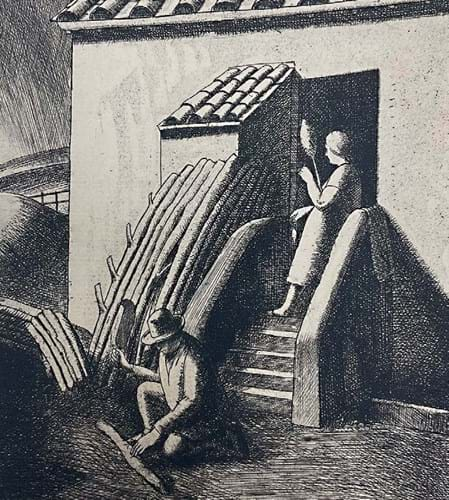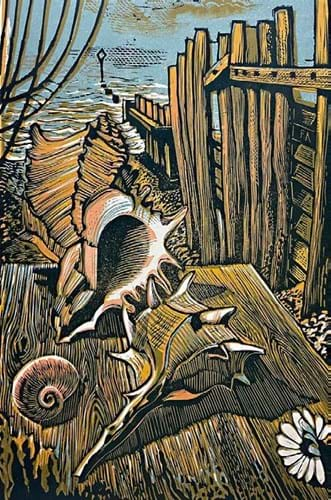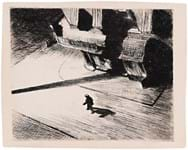The artist Frederick George Austin (1902-90) was a well-regarded printmaker in his day. However, although he received some notable recognition during his lifetime, he has never had a huge presence on the secondary market.
Today, works remain relatively affordable with his etchings generally selling for sums in the low hundreds of pounds. Indeed, the auction record for a print by the artist is £600 for a 1929 etching of an Italian soldier that sold at Mallams in Oxford in 2020, while the record for a work in any medium came in May last year when an oil painting of a farmyard made £1600 at the same saleroom.
Born in Leicester, he was the younger brother of Robert Sargent Austin (1895-73) – also an artist and illustrator – whose works tend to sell for rather more, seemingly over double the price.
Frederick Austin studied at Leicester School of Art and at the Royal College of Art between 1924-7 and followed in his brother’s footsteps by winning the Prix de Roma for engraving (first Robert in 1922 and then Frederick in 1927).
His earlier prints tended to show Robert’s influence but Frederick went on to adopt a more individual approach, combining rustic and religious subjects that were in keeping with the English pastoral tradition as well as more modernist styles that were prevalent at the time.
He went on to exhibit regularly at the Royal Academy and the Royal Society of Painter-Printmakers and taught etching and engraving at various schools. He lived for many years in Canada and today examples of his work can be found in the collections of the Ashmolean, British Museum, V&A and Graves Art Gallery in Sheffield.
One reason he may have fallen behind commercially was the fact that he was one of the few printmakers who mostly continued to use traditional techniques rather than adopt the new forms that were emerging in the post-war period. His works were also typically small (and frequently monotone) and tended to appeal more to print specialists rather than general buyers looking for more decorative works.
Even though Austin’s prints mostly ran into editions of 50, examples remain uncommon at auction.
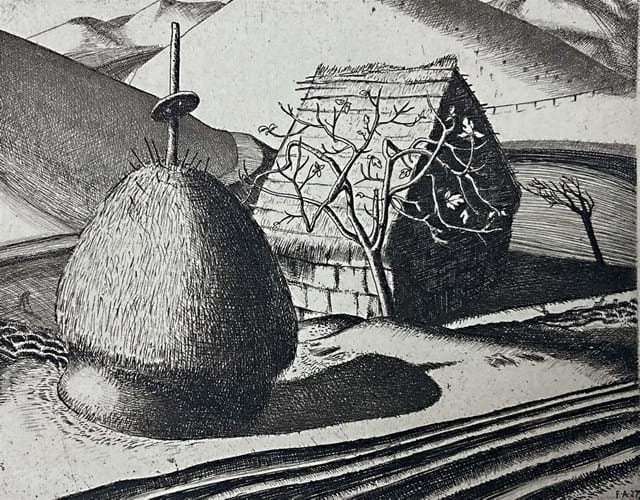
Haystacks – Roman Campagna, drypoint etching by Frederick George Austin, £220 at Duggleby Stephenson.
Family consignment
A notable group of 12 prints did emerge at the Fine & Affordable Art sale at Duggleby Stephenson (22% buyer’s premium) of York on January 5.
Consigned directly from the artist’s granddaughter, they were well-inked impressions, signed in pencil and in good condition. All 11 etchings and a single linocut sold for a combined £1760. A further group of eight etchings, three linocuts and three watercolours from the same source were then offered in a February 2 sale, raising a further £2090.
Leading the first tranche was a drypoint etching of a woodcutter and his wife titled The Little Household. Measuring 5½ x 4¾in (14 x 12cm) and dating from 1929, it had an intriguing composition with the two figures facing in different directions and the use of heavy cross-hatching for tonal effect.
The lot was one of around half the Austin lots that sold to a single buyer – a gallery – although the saleroom reported multiple buyers, both in the room and online, for the other works in the collection.
Another lot bringing decent competition was a 6¼ x 6in (16 x 15cm) drypoint etching from 1926 titled A Woodman Resting. One of the works produced while he was still a student, it was signed, titled and dated in pencil. Estimated at £100-200, it attracted a bid of £190.
The sole linocut at the sale was a more colourful depiction of seashells which was probably a later print and slightly larger at 14½x 9¾in (37 x 25cm). It took a top-estimate £200.
Two contrasting prints from different periods of the artist’s career led the second selection of works on February 2. An early drypoint etching depicting haystacks in the Roman countryside was signed and dated 1927, the year the artist left the Royal College of Art. Measuring 4¼ x 5½in (11 x 14cm), it came from an edition of 50 and surpassed a £100-200 estimate, taking £220.
The same price was bid for a larger linocut which was signed and dated 1954 and offered with the same estimate. Rooftops in a Continental Town measured 17¼ x 12½in (44 x 32cm) and seemed to benefit from its attractive tonal and stylistic features.
While these prices might not represent a major boost in Austin’s values, they did nevertheless establish a market benchmark for the various editions that will at least provide a reference should further examples appear.
Architectural speciality
Also on offer at the York auction in January was a print depicting the Pantheon in Rome by Hedley Hilton (1859-1929).
The Manchester-born artist specialised in architectural etchings and is known to have produced views of buildings in London, Edinburgh, Paris and Florence among other European cities.
In 1907, he won the Gold Medal awarded by the Société des Artistes Français although the critic Huntly Carter wrote in The Daily Chronicle that, even if his works were “direct and well-drawn” they were “lacking in charm and individuality” and the artist ‘would be wise to spend more care and skill in finishing his work, and not leave so many inches of surface uncovered’.
This signed drypoint etching was deemed one of his better efforts and, measuring 17¼ x 21¾in (44 x 55cm), it came to auction in good condition from a different vendor whose recently deceased relative had compiled a notable collection.
Estimated at £50-100, it drew good bidding from a number of interested parties and was knocked down at £400.
Other than an etching of an Parisian street scene that made £660 at Mallams in Abingdon in 2014, the price represented the highest auction sum recorded for the artist (source: Artprice.com).
Rare Cain British views
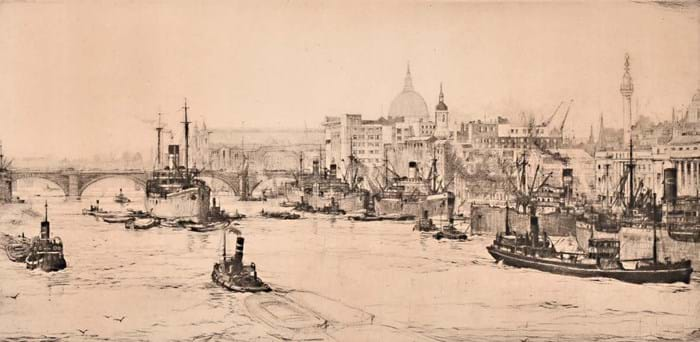
The Pool of London, one of a group of three prints by Charles Cain that sold together for £3200 at Parker Fine Art Auctions.
Another group of drypoints bringing attention at the start of the year were three prints showing views of London by Charles William Cain (1893-1962).
Offered as a single lot at Parker Fine Art Auctions (25% buyer’s premium) in Farnham on January 11, they each depicted scenes on the Thames.
One showed The Pool of London with St Paul’s Cathedral and Monument to the background. Another titled Big Ben Looks Down depicted a view at Westminster, while the third featured a barge sailing down the river at Greenwich.
Cain built a reputation for Orientalist subjects – he had served in the Border Regiment in India and Mesopotamia in the First World War – and after the end of the war the Imperial War Museum purchased 30 of his drawings.
While the majority of the prints he produced were views of the Middle East, India and Burma, British subjects were much rarer although not unheard of.
The prints offered at the Surrey sale were copies not often available on the market and, each signed in pencil and measuring 7¼ x 14¾in (18 x 37cm), they were deemed an attractive proposition especially against an estimate of just £200-300.
Bringing strong interest on the day, the lot was knocked down at £3200 to an online buyer.
The price appears to be the second highest for the artist at auction, behind only another drypoint of a non-Orientalist subject: a view of Castle Elizabeth in Jersey that sold at £4000 in a Dominic Winter sale back in 2001.


